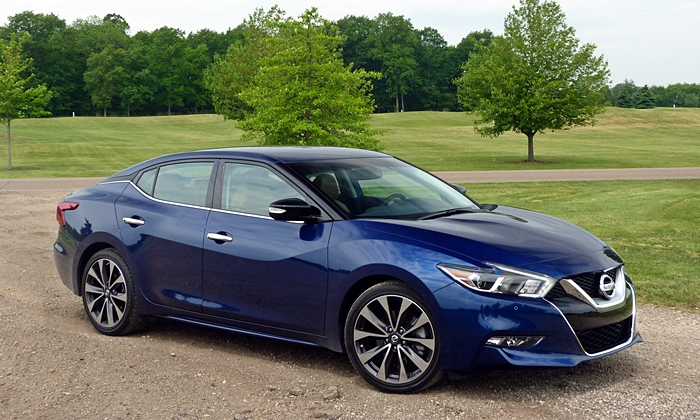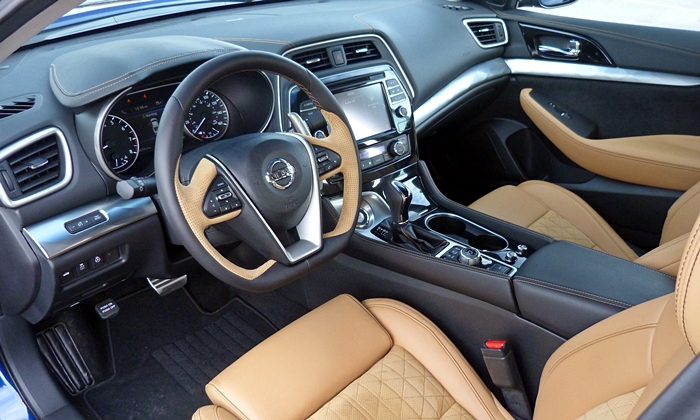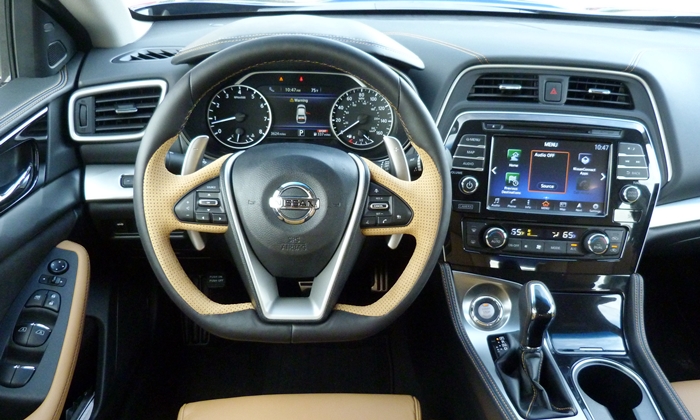Back in the 1980s, fun-to-drive "sport" sedans were a new concept. Towards the end of the decade, Nissan could label the third-generation Maxima a "4-Door Sports Car (4DSC)" and the common reaction was not a cynical "whatever" but "I want one." The Maxima's sales continued to build through the 1990s, peaking over 130,000 at the end of the decade.
The 2000s weren't kind to the Maxima. Market segments fragmented, competitors (including a couple in-house) proliferated, demand shifted, and it became increasingly unclear what a semi-premium, semi-large sedan might do to regain its formerly prominent position in the automotive world.
For 2016, Nissan is taking another stab at re-establishing the Maxima as the "4-Door Sports Car." But not only as a "4DSC." For those who don't care about performance and handing, the redesigned sedan includes additional luxury, technology, and safety features.
Are the changes enough to regain at least a portion of the car's former glory? To give the new 2016 Maxima a fair shot, I won't be pitting it against the highest performance cars with prices in the 30s. Those tend to be more compact than the Maxima, and to drive the rear wheels. They also tend to end up with far higher prices when loaded up. Upscale division Infiniti fields the Q40 and Q50 in that contest.
Rather, the Maxima contends for buyers who aren't hardcore driving enthusiasts, but who want a somewhat sporty, somewhat luxurious twist on the somewhat large, somewhat premium front-wheel-drive sedan. Most likely competitors include the Acura TLX, Buick LaCrosse, Hyundai Azera, Lincoln MKZ, and Toyota Avalon. Relax the "front-wheel-drive" criterion, and the Dodge Charger might also warrant inclusion, but it's very much an orange (a large, tasty one) amidst apples. In market positioning and specs, the TLX is the closest match for the Maxima. Which does the 4DSC dance best?

The undulating character line dips low through the doors. Too low? more Maxima photos

Eye-catching interior is as full of design elements as the exterior, but these work better.
| |
Compared to the TLX |
| Interior styling |
 Better
Worse
Better
Worse
|
I reviewed the Acura TLX in four-cylinder 2.4 form just a few weeks ago. While I liked some things about the replacement for both the TSX and the TL, I didn't care for the car's styling, inside or out. The TLX isn't an ugly car, just a boring one, at least for the eyes. I described its interior as "thoroughly generic." This opens up an opportunity for the new Maxima to score some points.
Score the Maxima does. Especially inside the sporty SR model well-executed eye candy abounds. The instrument panel, door panels, and center console are adorned with real constrasting stitching. The steering wheel, door panels, and center panels of the seats are trimmed with Alcantara synthetic suede. In the case of the seats, this Alcantara is quilted in a diamond pattern, a treatment limited until recently to cars costing at least double the Maxima SR's price. The trim strips on the instrument panel and doors have a faceted surface. The infotainment system's control knob is knurled like the stem of a fine watch. Stuffing so many highly styled elements into a single interior could easily yield a hot mess, but it all works inside the Maxima SR. I'd much rather spend time inside this car than inside the TLX.
| Exterior styling |
 Better
Worse
Better
Worse
|
The new Maxima is the second model to receive Nissan's latest, somewhat bizarre design language, following the third-generation Murano. To my eye, the undulating character lines, full curves, and "floating" roof don't work quite as well with the sedan's proportions as they do with the crossover's. This is not a pretty car. But it is much more likely to receive a second, even a third glance than the Acura TLX, which took a baby step in the same aesthetic direction. The Nissan's exterior design is at least interesting. Like other intentionally polarizing designs, some people will hate it, but others will buy the car because of it.
One site member likened the new Maxima to the Mazda6. But the Mazda, with more athletic proportions (thanks to a lower hood and a greater distance between the front door and the front axle) and more restrained (but not overly restrained) surfacing, is a beautiful car.

A black strip of C-pillar trim creates a "floating" roof. It will trickle down to other Nissans.

The Maxima boasts 15 inches of vivid displays. Controls are close at hand and not too complicated.
| Front seat support & comfort |
 Better
Worse
Better
Worse
|
Starting with the 2013 Altima and continuing with the 2015 Murano, the latest Nissans have had exceptionally comfortable front seats. The new Maxima's seats are based on the Altima's, but have some additional padding. While they don't feel as cushy and form-fitting to me as the Murano's, they're still more comfortable than the Acura TLX's front seats, which are themselves pretty good. The side bolsters are of similarly moderate size and aggressiveness in both cars, but the Maxima SR's Alcantara upholstery prevents sliding much better than the TLX's leather.
| Powertrain performance |
 Better
Worse
Better
Worse
|
With the Nissan Maxima's redesign, revisions to the 3.5-liter V6 bump horsepower from 290 to 300, a new CVT (continuously variable transmission) has a broader range, and curb weight has been reduced by about 80 lbs. While these changes are welcome, they don't significantly affects the car's performance. Acceleration remains similar to that of other V6-powered, front-wheel-drive midsize sedans. They're all quite quick. Figure about six seconds flat for a run to 60 mph.
Historically, powerful engines haven't paired well with front-wheel drive. But the engine in the new Maxima only gives the steering wheel a few light tugs when you put your right foot to the floor. Traction is a bit trickier when turning while accelerating, but electronic controls effectively manage it. (I wouldn't be surprised to learn that engine output is reduced during low-speed turns.)
Many people automatically reject any car with a CVT (continuously variable transmission). Nissan has worked hard to counter their objections. While the transmission operates like the stereotypical CVT in casual driving, placing the engine at the optimal rpm for the situation and leaving it there, it mimics the behavior of a close-ratio stepped automatic transmission in aggressive driving, letting engine speed build then cutting it back in roughly 500 rpm increments. This slightly sacrifices performance to provide a more "natural" feel and soundtrack. With the SR, drivers also have the option of employing the paddle shifters to select from among seven fixed ratios.
A bit more about that engine soundtrack: it's literally a soundtrack. Nissan has joined the recent trend of enhancing the sound of the engine by playing a recording through the car's audio system during hard acceleration. This enhancement does effectively sportify the driving experience, but car enthusiasts prefer such sensations to be authentic. Engaging sport mode via a button on the center console slightly increases the volume of this piped-in growl.
| Handling |
 Better
Worse
Better
Worse
|
I'm reluctant to list handling among the reasons to buy the new Nissan Maxima, as in absolute terms it's not especially fun to drive. But in relative terms it's at the top of its class--if, once again, we exclude the inherently more dynamic rear-wheel-drive Dodge Charger.
Focusing on the competition presented by the Acura TLX, each car has some advantages over the other. The Acura responds more quickly to steering inputs and feels more agile, partly because of a standard rear-wheel-steering system. But the Maxima SR's suspension better controls body motions and its performance tires, especially the W-rated three season tires offered as a $450 option, grip the road far better than the TLX's so-so touring-spec treads. (Maximas other than the SR are shod with tires much like those on the TLX. They also lack the SR's torque vectoring, which like the system standard in the TLX selectively applies the brakes to counteract understeer.) If the TLX were fitted with more sporting dampers and tires it would be the better-handling car. In stock form, the Maxima SR is.
| |
Compared to the TLX |
| Feature availability |
 Better
Worse
Better
Worse
|
Unless you can't stand the new Maxima's exterior styling--and no doubt more than a few people can't--there aren't any strong reasons not to buy one--unless you feel that 300 horsepower should be channeled through more than just the front tires. Some competitors, including the Acura TLX, are available with all-wheel drive. The Maxima is not.
Or you might want a sunroof. You can get a panoramic sunroof in the Maxima, but only in the less athletic SL and Platinum grades. Nissan has opted to offer the 2016 sedan in five trim levels with virtually no options. If you want the SR, you can't get a sunroof. Allegedly this was done because a sunroof would raise the car's center of gravity, and cause the car to lean more in hard cornering. But plenty of higher performance cars are offered with sunroofs.
In the new Maxima's defense, it does tend to be very well equipped for a given price point. Navigation, a pair of large displays, proximity key, dual power seats, and remote start are standard on all five variants. The SV adds, among other things, heated leather seats and obstacle detection at both ends. The SL adds Bose surround-sound audio, adaptive cruise control, forward collision warning, blind sport warning, and a heated steering wheel (plus the panoramic sunroof not available on the SR). The SR adds LED low beam headlights and ventilated front seats (in addition to the sport bits). The Platinum adds an around-view camera system, moving object detection, memory for the driver seat and a power-adjustable steering wheel, rain sensing wipers, and a telematics sytem (plus fake mahogany trim I could personally do without).
If you don't need a sunroof on the SR or all-wheel-drive, then feature availability is more a strength than a weakness.
| Rear seat room & comfort |
 Better
Worse
Better
Worse
|
If you need an especially roomy rear seat, then the Maxima isn't your best bet. The Nissan does have an inch or two more rear knee room than the Acura TLX, and about an inch more rear headroom than the Lincoln MKZ (perhaps enough for someone six-feet tall), but the LaCrosse, Azera, and Avalon offer enough rear seat space for adults to not only fit but stretch out.

The new face of Nissans. Plus a power dome stamped into the hood.

The rear seat is just adequate. What did you expect in a sports car?
The roads on the test route weren't sufficiently chewed up to properly evaluate the Maxima's ride quality. As far as I could tell, it seemed at least passable.
To reduce noise levels inside the Maxima, Nissan added laminated front door glass and, on the top three trim levels, active noise reduction. But the laminated glass doesn't do anything for road noise, and on coarse pavement there was an above-average (if still well short of discomforting) volume of it, especially for people riding in the back seat. Acuras have long suffered from road noise, but the TLX might have a slight edge in this regard. I'd need to drive both cars on the same roads to verify this.
| |
Compared to the TLX |
| Fuel economy |
 Better
Worse
Better
Worse
|
Historically, Nissan's 3.5-liter V6 was a somewhat thirsty engine. But continuous improvement to both it and the CVT yield, in the 2016 iteration, EPA ratings of 22 mpg city, 30 mpg highway. No V6-powered competitor does significantly better, and some (such as the Buick and the Hyundai) do a few mpg worse. The Acura TLX 3.5 checks in at 21/34, the Avalon at 21/31.
But for people who don't need 300 horsepower, there are more efficient alternatives. The four-cylinder Acura TLX manages 24/35, and the Avalon Hybrid scores 40/39. For people who prioritize fuel economy far above strong acceleration, Nissan offers no alternative to the V6. (A diesel was promised a few years ago, but never materialized.)
| Price or payments |
 Better
Worse
Better
Worse
|
Pricing for the new Maxima runs from $33,235 for the S to $40,685 for the Platinum. The SR checks in near the top of the range, at $38,495. Add a couple hundred dollars to all of these prices for floor mats. Add another $450 to the SR if you want the W-rated tires.
The Hyundai Azera is the only close competitor that costs significantly less than the Maxima SR, and even then only in its base trim, and only if you consider a feature-adjusted difference of about $1,800 to be significant. The Buick LaCrosse and Toyota Avalon both cost about $3,000 more than the Maxima SR.
And the Acura TLX? In V6 Tech form it costs $1,395 more, but includes about a grand in additional content owing to its full-LED headlamps, rear-wheel-steer system, and sunroof. Adjust for such differences, and the Acura is only about $400 higher. But maybe you want adaptive cruise control, obstacle detection, and ventilated front seats. While these are standard on the Maxima SR, you need to step up to the Advance model to get them on the TLX. Do this, and the TLX lists for $4,645 more while including about $4,000 in additional content, for a feature-adjusted difference around $600.
I should note that these calculations value the TLX's all-wheel-steering system at $1,500, since this costs at least this much as an option elsewhere. But it's an option few people opt for, suggesting that it's not worth $1,500 to many people. What is this feature's agility enhancement worth to you? Adjust the above feature-adjusted price differences vis-a-vis the TLX accordingly.
Before moving on, I'm going to toss in a ringer. The big, brawny, comfortable yet entertaining Dodge Charger SXT with the full-zoot Premium Group lists for $1,765 less than the Maxima SR, AND includes about $2,000 in additional content. If, when shopping for an apple, you come across a large bargain orange, what do you do? I suppose it matters how much you value the Maxima's more exquisitelly furnished interior relative to the Charger's big-car feel and rear-wheel-drive dynamics.
With some dramatic strengths and just a few weaknesses that aren't very weak, the new Nissan Maxima scores well against the Acura TLX. Is it a sports car that just happens to have four doors? Not really. But compared to other cars in the same class it performs and handles better. If I must grade on a figurative curve rather than a literal one and award either the Maxima or the TLX the 4DSC title, the Nissan gets it.
The most appealing aspect of the new Maxima isn't its performance or handling, though. It's the chock-full-of-design interior. Acura: this is how it's done.

Technology makes Nissan's powerful V6 sound even better.

Average-sized trunk.
See more 2016 Nissan Maxima photos
Nissan provided insured, fueled cars and two meals at an event for invited media. Acura provided an insured car for a week with a tank of gas, plus a second TLX at an earlier regional media association event.











